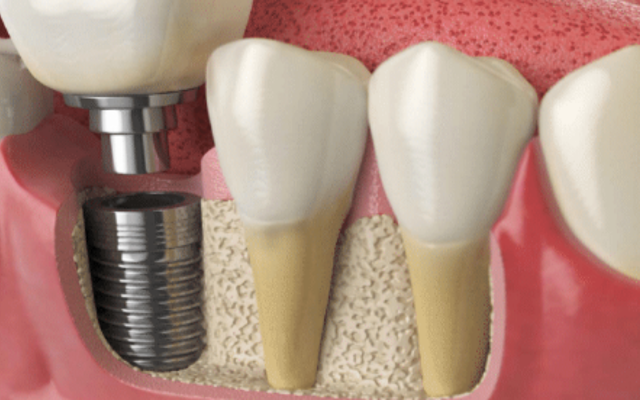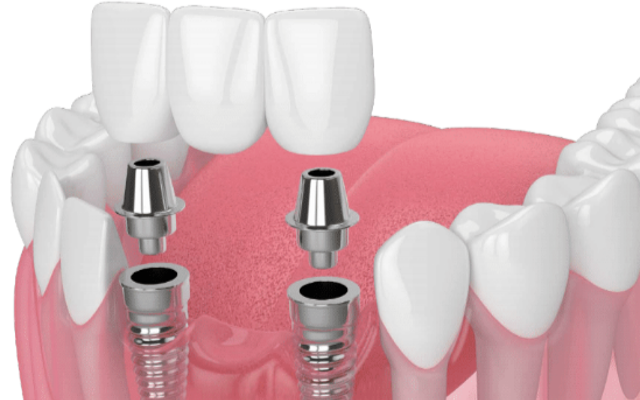Dental Implants

Dental Implants Explained
You may have heard of dental implants, or your dentist has recommended dental implant treatment to you. Dental implants are widely used in dentistry to replace missing teeth. The first modern dental implants were developed in the 1960s and 1970s and have been extensively researched over the last 50 years. They have been shown to be a safe and reliable method for replacing teeth.
The following explains what dental implants are and how they are used to replace teeth.
What is a Dental Implant?
A dental implant is a small screw, usually made from titanium, that is inserted into the jawbone to replace the root of a tooth (Figure 14 A). Over a period of 2 to 3 months, the dental implant fuses and becomes anchored to the bone through a process known as osseointegration. Once integrated, the implant can withstand normal biting forces. Titanium is also used also used in orthopedics for joint replacements (e.g. hips and knees), and for bone anchored hearing aids.

How Do Dental Implants Replace Teeth?
Dental implants help to replace teeth in two ways, fixed or removable (Figure 14B). The first way is for a dental crown to be attached to the implant to replace a missing tooth. Several implants can be used to support multiple teeth connected by the implants (a bridge).
The second way is for the dental implant to be used to retain a removable denture. A clip, very similar to a press stud on clothing, is used to attach the base of the denture to the implant. In this way, one or several implants can be used to improve the retention and stability of a removable denture.
How Are Dental Implants Placed?
Dental implants are inserted into the jawbone in a minor surgical procedure in the dental office. Most of the time, the procedure is done after numbing the region to be treated with a local anesthetic injection, much in the same way that a tooth is numbed for a filling. In some cases, patients will choose to have sedation as well. The surgical component of care is best provided by an experienced clinician such as a specialist who has additional qualifications and advanced training. Precision dental drilling equipment is used with sterile saline irrigation. Sometimes, the dentist may recommend that the treatment is carried out with an anesthetist present (under Twilight Sedation or General Anesthesia), particularly if many implants need to be placed at the same time.

What Are The Risks?
Your general health is important. There are several conditions, for example if you have unstable diabetes or are a smoker, that can adversely affect the success of treatment.
The risks with dental implants can occur at three time points of treatment - at the time of surgery, the first 1 to 2 weeks after surgery, and the next 2 to 3 months after surgery.
At the time of surgery, increased bleeding may occur in patients who are taking blood thinning medications. It is important to discuss this with your dentist prior to treatment. There are also risks with anatomical structures in the area where the implant is to be placed e.g., the roots of adjacent teeth, or in the posterior region of the lower jaw where a nerve canal (inferior alveolar nerve) lies within the jawbone. If there is insufficient height of bone above the nerve canal, your dentist may recommend against implant treatment.
In the first few days after implant surgery, post-operative pain is usually mild and can be managed with over-the-counter analgesics and cold compresses. Minor post-operative bleeding should be expected and is normal. Excessive pain and swelling are unusual, and if this occurs, the patient should contact the dentist to manage this. Swelling and bruising of the face can sometimes occur in the region of the surgery.
Once initial healing has taken place, the implant gradually becomes attached to the bone over the next 2 to 3 months (osseointegration). Sometimes, however, an implant may not fuse to the jawbone and become loose. This is usually detected within the first 2 to 3 months of the implant being inserted. In most cases, the failed implant can be replaced after a short healing period.
How Long Do Dental Implants Last?
Modern dental implants have a high survival rate, with 10-year studies demonstrating survival rates of over 95%. Like most prosthetic devices, however, complications with dental implants can occur. The main long-term complications are infection (peri-implantitis) and loosening of the implant.
If implants are not cleaned properly by the patient at home, they can develop an infection which may damage the supporting bone. This infection, also known as peri-implantitis, begins in the gums surrounding the implants and can eventually damage the bone. Therefore, it is so important to comply with recall appointments so that your dentist can check the health of the bone and gums supporting the implant. Patients with a history of gum disease (periodontitis), smoking and uncontrolled diabetes have an increased risk of developing implant infections.
Implants can also be lost if bite forces exceed the capacity of the bone. As part of the recall and maintenance of the implant, your dentist will periodically check that the bite forces on the implant are balanced with other teeth. Patients who have a history of para-functional grinding (bruxism) are at increased risk with this type of complication.
You may need spare parts in years to come and you may be living in another country. You need ensure your implant/s come from a major international manufacturer, so componentry is available.
Authors:
Dr Stephen Chen
Dr Nicholas Cole